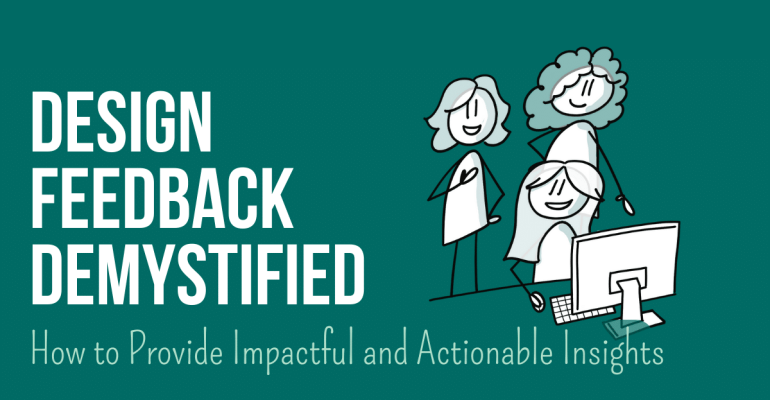Design Feedback Demystified: How to Provide Impactful and Actionable Insights
8. May 2023 2023-05-08 9:31Design Feedback Demystified: How to Provide Impactful and Actionable Insights

Design Feedback Demystified: How to Provide Impactful and Actionable Insights
If you’re passionate about creating exceptional user experiences and believe that constructive feedback is the secret ingredient to design success, you’ve come to the right place. Whether you’re a UX guru, a seasoned leader, or an aspiring design feedback maestro, this guide will equip you with the knowledge and skills to provide effective feedback that will elevate your team.
So, without further ado, let’s embark on this journey through the art of design feedback. Get ready to flex your communication muscles, embrace your inner collaborator, and sprinkle a dash of love onto the design process. Together, we’ll unravel the secrets of providing feedback that is both valuable and delightful. Let’s dive in!
Understanding the purpose of design feedback
In the vast world of design, feedback plays a crucial role in shaping remarkable user experiences. But before we dive into the nitty-gritty, let’s take a moment to understand the true purpose of design feedback.
Imagine you’re embarking on a journey to create a user-friendly website or a sleek mobile app. Design feedback is like a compass that keeps you on the right track. Its primary goals are to refine usability, enhance aesthetics, and ensure your design meets user needs. It’s all about crafting experiences that users will love and find effortless to navigate.
Effective feedback is the key to bridging the gap between designers and stakeholders. It encourages collaboration and ensures a user-centric approach throughout the design process. By providing feedback, UX and leadership professionals offer valuable insights, helping each other make informed decisions and fostering a culture of improvement.
Now, let’s imagine a world without feedback. It would be like driving blindfolded, hoping to reach your destination without guidance. Scary, right? Well, the same goes for design. Feedback is a guiding light, illuminating the path to success and preventing design missteps. It helps designers stay focused, iterate on their work, and create experiences that leave users wanting more.
Characteristics of effective design feedback
Providing effective design feedback is an art form that requires a mix of skill, tact, respect and empathy. Let’s explore the essential characteristics that make feedback truly impactful:
- Specificity: Generic feedback like “I don’t like it” or “This needs work” doesn’t cut it. Effective feedback is specific, pinpointing the aspects that work well or need improvement. Instead of saying, “I don’t like the color,” try something like, “The color palette feels a bit too bright for our target audience. Could we explore more muted tones?”
- Actionability: Feedback should be actionable, providing designers with clear steps. Avoid vague statements and focus on practical suggestions that guide them towards improvement. For example, instead of saying, “Make it better,” try offering specific recommendations like, “Could we simplify the navigation menu by condensing the categories and adding clearer labels?”
- Respectful Tone: Designers pour their heart and soul into their work, so providing feedback with a respectful tone is essential. Focus on the design aspects rather than criticizing the designer personally. Frame your feedback in a way that encourages growth and collaboration.
- Timeliness: Feedback loses its impact if delivered too late in the design process. Aim to provide timely feedback to prevent unnecessary delays and keep the design momentum going. Catching potential issues early allows designers to course-correct and saves time and effort.
- Balance: Effective feedback strikes a balance between positive reinforcement and constructive criticism. Acknowledge what’s working well and praise the strengths of the design. Balancing it out with areas for improvement helps maintain motivation and inspires designers to push their creative boundaries.
Remember, providing practical design feedback isn’t about being a design dictator or a fault finder. It’s about being a supportive partner in the design journey, guiding designers towards excellence.
Crafting constructive feedback
Now that we’ve explored the main characteristics of effective design feedback, it’s time to roll up our sleeves and dive into the art of crafting constructive feedback. Here’s a step-by-step guide to help you provide feedback that nurtures growth and empowers designers:
- Start with the positive aspects: Begin your feedback by highlighting what works well in the design. Celebrate the strengths and successes, reinforcing the designer’s efforts. This sets a positive tone and instils confidence in the designer’s abilities.
- Focus on specific areas for improvement: While acknowledging the positives, addressing the aspects that could benefit from refinement is essential. Be clear about the areas that need attention, such as layout, typography, or interaction design. This helps designers understand where to direct their efforts.
- Offer actionable suggestions: Don’t just point out flaws—provide practical suggestions and alternatives. Offer insights into how the design could be enhanced or optimized. For example, instead of simply saying, “The button doesn’t stand out,” provide a solution like, “Consider using a contrasting color or adding a subtle drop shadow to make the button more visually distinct.”
- Provide context and rationale: When giving feedback, explain the reasoning behind your suggestions. This helps designers understand the feedback’s purpose and its impact on the user experience. They can make more informed decisions when they know the “why” behind the changes.
- Use the “sandwich” approach: Sandwich constructive criticism with positive feedback. Start with a positive comment, provide the areas for improvement, and end with another positive note. This approach ensures that the input is well-balanced, supportive and fosters a growth mindset.
- Encourage dialogue and questions: Feedback is a two-way street. Encourage designers to ask questions, seek clarification, and provide their perspectives. Embrace open dialogue, active listening, and empathy to foster a collaborative feedback culture. Remember, great ideas can come from anyone, so be receptive to different viewpoints.
By following these steps, you can provide feedback that is both constructive and supportive. Remember, feedback is a journey of improvement, and it’s essential to provide guidance while empowering designers to take ownership of their work.
Collaboratively providing feedback
Feedback shouldn’t be a one-sided monologue—it’s a collaborative dance between designers and feedback providers. Embracing a collaborative approach can foster a supportive and productive feedback culture. Here’s how you can make the feedback process a true collaboration:
- Involve all designers in the feedback process: Designers are the experts in their craft, and their perspectives are valuable. Involve the whole team in the feedback process by encouraging them to share their thoughts, insights, and solutions. This empowers them to own their work and contributes to a sense of shared responsibility.
- Foster open dialogue: Create an environment that encourages open dialogue and discussion. Listen attentively to the designer’s viewpoint, and be open to alternative ideas. Remember, collaboration breeds innovation, so embrace the diversity of perspectives and explore different paths together.
- Practice active listening: When providing feedback, actively listen to the designer’s concerns and questions. Understand their intentions and design choices before offering your insights. You build trust and strengthen the feedback relationship by demonstrating that you genuinely care about their perspective.
- Empathy goes a long way: Put yourself in the designer’s shoes and empathize with their challenges. Understand the hard work, time, and effort they’ve invested in their design. Frame your feedback with empathy and kindness, ensuring it inspires growth rather than deflating their spirit.
- Celebrate growth and progress: As a feedback provider, acknowledge and celebrate the development and progress made by the designers. Recognize their efforts and improvements, providing encouragement along the way. This fosters a positive feedback loop and motivates designers to continue pushing boundaries.
- Embrace a continuous feedback loop: Feedback shouldn’t be a one-time event but a constant process of learning and improvement. Regularly check in with designers, provide ongoing feedback, and track progress. This iterative approach allows for incremental enhancements and cultivates a culture of continuous learning.
Remember, collaboration is the secret sauce that elevates design and brings out the best in teams. By embracing a collaborative feedback approach, you create an environment where creativity thrives and everyone has a voice.
Building trust and rapport in design feedback
Trust and rapport are the foundation of effective design feedback. When designers trust and feel supported by their feedback providers, they become more receptive to suggestions and more willing to take risks.
Here are some key elements to build trust and rapport in the design feedback process:
- Establish a safe and supportive environment: Create a safe space where designers feel comfortable sharing their work and receiving feedback. Foster a culture that values open communication, respect, and constructive critique. This helps designers feel safe to take risks and be vulnerable with their ideas.
- Focus on the work, not the person: When providing feedback, direct your attention to the design itself, not the designer. Avoid personal attacks or making it about individual capabilities. Instead, frame your feedback around improving the design and achieving shared goals.
- Be transparent and authentic: Honest and transparent feedback builds trust. Be authentic in your communication, expressing your thoughts and concerns genuinely. Designers appreciate sincerity and value feedback that comes from a place of authenticity.
- Highlight strengths and progress: Recognize and celebrate the strengths and progress made by the designers. Acknowledge the effort they’ve put into their work and provide positive reinforcement. Highlighting their successes inspires confidence and creates a supportive feedback culture.
- Offer constructive guidance, not directives: Instead of dictating changes, provide advice and suggestions that empower designers to make informed decisions. Encourage them to think critically and explore different solutions. This fosters a sense of ownership and encourages designers to take their work to new heights.
- Follow up and follow through: When designers see their feedback is heard and actioned, it builds trust. Follow up on previous feedback sessions, check the progress, and acknowledge the changes made. This demonstrates your commitment to their growth and creates a sense of partnership.
Trust takes time to develop, and it’s crucial to nurture it consistently. When designers feel supported and trust their feedback providers, they become more receptive to feedback and more likely to take risks in their designs, leading to more innovative approaches.
Conclusion
Design feedback is the catalyst for growth, improvement, and innovation. It’s a collaborative dance that requires empathy, openness, and a supportive mindset. By providing feedback with competence, approachability, warmth, and authenticity, you inspire designers, igniting their creative fire and fueling their passion for exceptional design.
As feedback providers, you can make a lasting impact on the design process and the designers’ development. By embracing specificity, actionability, respect, timeliness, balance, and collaboration, you create an environment where feedback becomes a catalyst for excellence.
Remember, the journey doesn’t end here. Design feedback is an ongoing process of refinement, iteration, and growth. Continuously hone your feedback skills, adapt to new challenges, and remain open to learning from designers, stakeholders, and the ever-evolving design landscape.
If you’re ready to level up your UX and leadership game, I invite you to work with me as your coach. Together, we’ll dive deeper into the intricacies of design feedback, explore effective leadership strategies, and nurture your growth as a professional. Browse my website to learn more and schedule a coaching session here 👈.
Further Reading
Constructive (n.d.). 5 Tips for Giving Great Design Feedback. https://constructive.co/insight/giving-design-feedback/
InVision (n.d.). Design feedback. https://www.invisionapp.com/defined/design-feedback
Jose, L. (2021). How to Give Great Design Feedback (That Designers Will Use). Superside. https://www.superside.com/blog/giving-design-feedback







